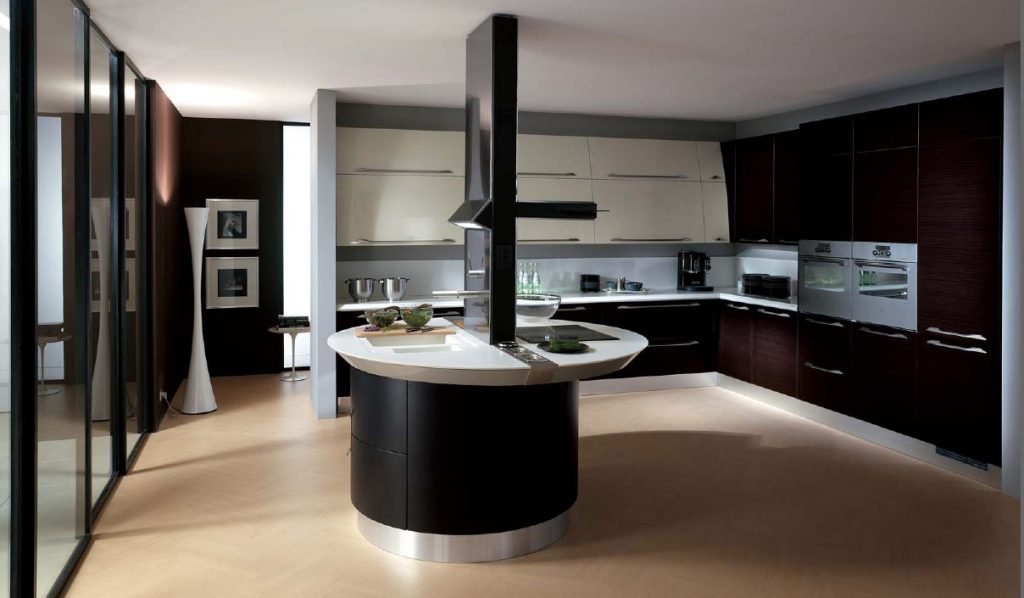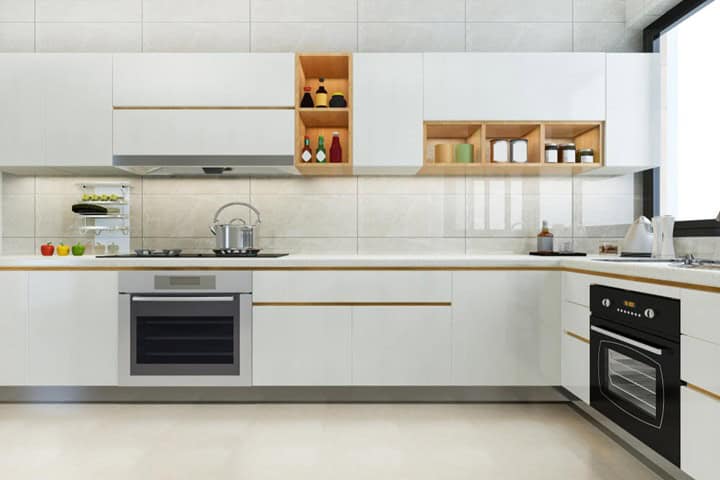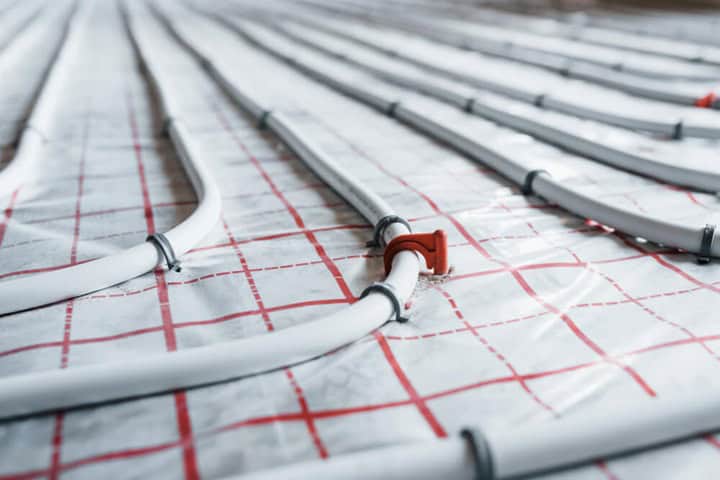
Can you fit underfloor heating in kitchens? The answers may surprise you, and they can be just as comforting! Learn about adding underfloor heating in kitchens here.
Among all the rooms in the home that you could integrate underfloor heating into, one of the most common is the kitchen. Kitchens are usually made up of tiled or vinyl flooring, perfect additions for underfloor heating to mitigate heat from. But how can this be done? In this article, we will delve into why this heating solution is perfect for kitchens, discussing everything from space efficiency to the best materials for heat conductivity. Learn how to tailor underfloor heating around your kitchen’s layout and discover the most cost-effective and energy-efficient systems available today.
If you are looking to install or renovate a kitchen before adding in underfloor heating, be aware of these kitchen installation mistakes.
Key points:
- Learn how to eliminate the need for bulky radiators and maximise your kitchen space.
- Understand which flooring materials work best with underfloor heating.
- Analyse the costs involved and the long-term savings potential.
- Tips on how to integrate underfloor heating with your current or new kitchen design.
- Advice on selecting a supplier that meets your specific underfloor heating needs.
Why Opt for Underfloor Heating in Kitchens?

The kitchen is often called the heart of the home, serving as a central hub for cooking, entertaining, and relaxing. Underfloor heating for kitchens improves this space by providing an ‘invisible’ heating system that doesn’t compromise on space or style.
Unlike traditional heating methods that occupy wall space such as radiators, underfloor heating in the kitchen remains out of sight, offering a clean and uncluttered look perfect for modern kitchen new build designs. Of course, this environment can provoke more obstacles when adding underfloor heating in kitchens, from the sinks, to washing machines and the oven.
This is why it is important to hire a professional to install your underfloor heating so that any potential obstacles can be highlighted prior to installation to avoid system failure.
Better Comfort and Space
Whether renovating or building from scratch, incorporating kitchen underfloor heating can significantly elevate the level of comfort.
Radiant floor heating systems distribute heat evenly across the floor, creating a warm and welcoming environment right under your feet. It allows for the total utilisation of wall and floor space, as no radiators are necessary, giving you the freedom to design your kitchen without constraints.
Energy Efficiency
Underfloor heating systems are not only comfortable but also energy efficient. By providing heat directly from the floor up, these systems ensure minimal heat loss and maintain consistent temperature throughout the space.
This efficiency translates into lower heating costs over time, making underfloor heating in a kitchen a wise choice for energy-conscious homeowners.
Electric underfloor heating systems, in particular, are known for their low operational temperatures and high efficiency, which is crucial for keeping utility bills in check.
Selecting the Ideal Flooring for Kitchen Underfloor Heating
The choice of flooring in your kitchen plays a crucial role when integrating underfloor heating. Ceramic tiles are particularly popular due to their durability, they are easy to maintain, and are available in a wide range of colours and designs. This versatility allows homeowners to tailor the kitchen’s aesthetic to their taste while benefiting from the tiles’ excellent heat conduction properties.
Tiles are ideal for underfloor heating in kitchens because they distribute heat efficiently and maintain it longer.
While thicker tiles may slightly delay the heating process, they retain warmth well, making them a preferred choice for energy conservation.
Standard tiles, usually 10mm to 12mm thick, are optimal as they balance quick heat-up times with effective heat retention.
Alternatives to Tiles
Do you not think porcelain or ceramic tiles are better for your kitchen? If you’re considering alternative flooring options for your kitchen, like wood, vinyl, or laminate, it’s important to understand their specific characteristics in relation to underfloor heating.
These materials can be used with underfloor heating systems, but they have temperature limitations to prevent damage and maintain structural integrity.
For instance, wood, vinyl, and laminate should not exceed 81°F (27°C) to avoid warping or other heat-related issues. Learn more about the best flooring for underfloor heating in our informative guide to help you make your decision.
Understanding the Best Underfloor Heating Systems for Kitchens

Using underfloor heating in the kitchen requires careful consideration of the installation process to lower the risks and allow the system to perform better.
One potential issue is the risk of tile cracking or grout damage from thermal expansion, commonly caused by temperature fluctuations. To reduce this risk, ensure that a flexible, cement-based adhesive and grout are used for laying tiles, which will accommodate the thermal expansion and contraction.
Another concern is the potential damage to heating cables during installation, particularly with electric underfloor systems. It is crucial to ensure that the subfloor is level and that any installation activities are conducted carefully to prevent damage to the heating elements.
Decoupling Systems
Heating and decoupling systems in kitchen underfloor heating marks a significant advancement in floor heating technology.
These systems feature a decoupling membrane that serves several functions: it protects tiled floors from damage due to thermal expansion and contraction, and secures the heating cables in place. This is particularly effective in kitchens where the floor must withstand frequent temperature changes without cracking or lifting.
The unique design of the decoupling layer allows the tiles above to move independently from the subfloor, thus reducing the risk of damage. By adjusting the spacing between the heating cables—such as two-stud or three-stud spacing—homeowners can customise the heating output to suit the specific needs of their kitchen, ensuring efficient and even warmth distribution.
Mesh Mat Systems
Mesh mat systems represent a more traditional approach to underfloor heating in kitchens. These systems typically consist of a heating cable fixed to a mesh backing, which is then laid beneath the kitchen tiles. The pre-spaced arrangement of the heating cables ensures an even distribution of heat, making it ideal for maintaining a consistent temperature across the kitchen floor.
However, installation requires care to avoid damaging the heating cables with tools during the laying process. For added protection, some mesh mat systems are designed to be installed wire side down, which helps shield the heating cables from potential damage caused by installation equipment.
Prioritise Insulation
Insulation is a crucial component of an efficient underfloor heating kitchen system. Without proper insulation, much of the heat generated by the underfloor cables can be lost to the substrate below, leading to increased heating times and higher energy costs. By installing insulation boards, these will protect your flooring whilst aiding in emitting heat within the kitchen.
Follow this common underfloor heating problems guide which underlines other risks that you may encounter prior to installation.
Choose Underfloor Heating For Your Kitchen
In conclusion, opting for underfloor heating in your kitchen can improve, not only the room’s functionality, but also its overall design and comfort. By integrating this system, you can save space, tailor heating around your kitchen’s unique layout, and select a flooring option that maximises heat efficiency. Whether you’re refurbishing an old kitchen or designing a new one, underfloor heating is a savvy, stylish choice that promises to keep your kitchen warm and welcoming for years to come.
FAQs
Is it worth having underfloor heating in a kitchen?
Yes, it is worth having underfloor heating in a kitchen. It offers efficient space heating, creates a more aesthetic and uncluttered space by removing the need for radiators, and provides an even amount of warmth, increasing comfort in what is often the most used room of the house.
Can you have underfloor heating under kitchen units?
It is not recommended to install underfloor heating under kitchen units where heat will not circulate well and energy could be wasted. Instead, the heating should be installed around such fixed units to ensure efficient use of energy and effective distribution of heat where it’s needed.
Sources
Ashford Kitchens & Interiors. (2024) Avoiding Kitchen Installation Mistakes; Common Issues and How to Prevent Them. [online] Available at: https://www.ashfordkitchensandinteriors.co.uk/blog/avoiding-kitchen-installation-mistakes-common-issues-and-how-to-prevent-them/ [accessed 14/10/2024]
